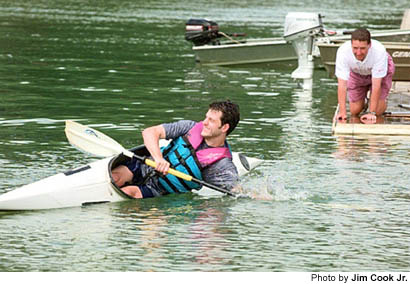
June 22, 1999 — I remember when my father first taught me how to ride a bicycle — back in days when kids’ heads were hard enough not to require helmets.
Holding onto my seat, he ran by my side as I steered the small bike throughout my elementary school’s macadam playground.
And then he let go, and watched his son take the first few unassisted pedals of his life — and ride the bike directly into a brick wall.
The bicycle stopped moving. I didn’t, and ended up with my legs wrapped around the handle bars.
I cried.
During our next riding lesson, my father made sure to teach me the importance of using the brakes.
So when Lanier Canoe & Kayak Club head coach Tony Hall told me that learning to paddle a sprint kayak is “just like learning how to ride a bike,” I knew I was in trouble.
But I also knew I was in good hands. In his more than 20 years of coaching, Hall has trained national champions, world champions and Olympians. In his two short years on the job at Lanier, he has turned the paddling club into a national power.
Those feats likely seemed simple compared to his time spent trying to instruct me on the basics of paddling sprint kayak and canoe. Let’s just say it’s a good thing I brought a spare set of clothing.
I’ve seen sprint paddling done properly many times before. The Lanier athletes, some of them likely future Olympians, make it look so easy, so graceful. They glide smoothly, seemingly effortlessly, through the water.
Supposedly, however, even the best of them spent a good bit of time in the water, instead of on it, while learning how to balance these terribly tippy boats. But typically the smaller you are, the easier it is to get the hang of.
Those of us who are “tall and gangly,” Hall said, find it harder to control our center of gravity.
“Well,” Hall added, looking me up and down. “You’re only semi-gangly.”
To build my confidence, and to let me get some practice with the paddle, Hall let me tool around a bit in a Scupper, the almost untippable sit-on-top kayaks most beginners use.
“See, easy as pie,” Hall smiled as I returned to the dock behind the Clark’s Bridge Park boathouse, part of the 1996 Olympic venue. “That boat will keep your balance for you. But when you get in here … ”
Hall chuckled and shook his head. He was pointing to the sprint kayak I was preparing to enter. I wasn’t in on the joke — not yet, at least. Soon I would be the punchline.
I would have tipped the boat right there at the dock if Hall wasn’t steadying it with his hand as I gracelessly shimmied my way into the craft.
“Getting in is always the biggest hurdle,” snickered Hall, 40, from Dartmouth, Nova Scotia, who came to the Lanier club in 1997 after coaching Canadian Olympians in the 1996 Games in Gainesville.
I used my hands to paddle at first, trying to attain a comfortable sense of balance inside my vacillating vessel. I didn’t, but I managed to stay dry.
Enter the paddle. Five seconds later I was swimming.
“The paddle, when you start, is actually a liability,” said Hall, looking down at me, a broad smile spreading across his face.
Now I learned the “tip, turn and tow” routine, what paddlers are taught to do in the event of a spill. I had already accomplished the “tip” part. Now I had to “turn” the kayak right-side-up and “tow” it back to the dock. I didn’t have far to go.
I got pretty good at the tip, turn and tow. I also mastered the practice of emptying the boat of water. Enough cannot be said about the merits of repetition.
“I’m going to give you a bigger push to get you going this time,” said Hall after I got myself back in the kayak. “There you go. That’s bett … ”
Splash.
“A three hour tour,” Hall sang.
It’s a helpless feeling, the one when you realize you’re rolling a sprint kayak. Instinct tells you to rock the other way. Coaches, like Hall, will tell you to break your fall by bringing the paddle down flat on the water. Neither worked for me.
One more try.
“Just relax. There you go. Use your paddle. Little strokes. Little strokes. That’s it. That’s a save. Good … ”
Splash.
“Almost. New record,” said Hall. “OK, so now that you’ve mastered the kayak … ”
It was time for me to try the sprint canoe. And if learning the sprint kayak is like learning how to ride a bike, then the learning the sprint canoe is like learning how to pilot a jet airplane … in a blizzard … while blindfolded.
These aren’t the same canoes you paddled as a boy or girl scout. They’re sleek, stream-lined crafts that look better suited for space travel. And the paddling position — down on one bent knee, with the other foot placed directly ahead several inches — is a wobbly one, even on dry land.
The cruel irony of the canoe is that once you learn how to stay balanced on the water — which, by the way, I am still not convinced is possible — it is likely you will just go around in circles, because the paddle stroke can only be made from one side of the boat.
I never made it away from the dock.
Sure, just like learning how to ride a bike, right?
At least Lake Lanier didn’t have any brick walls for me to run into.
